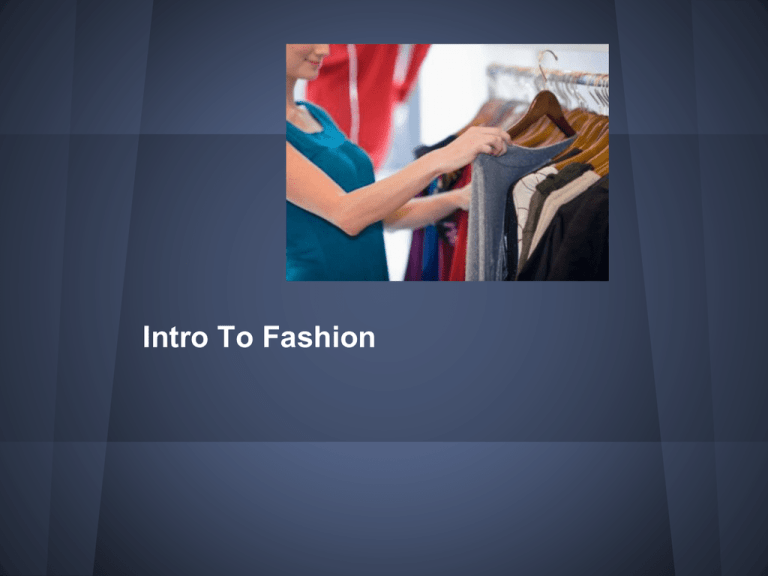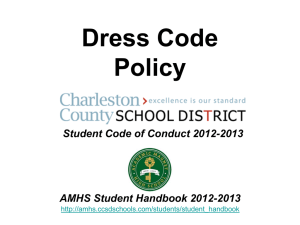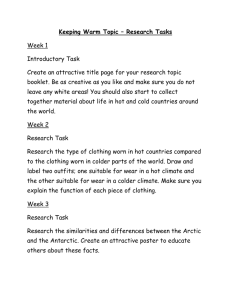fashion chapter 1 - fashionandtextiledesign
advertisement

Intro To Fashion Why Clothing? Clothing does more than just cover your body! ● Influences you as a consumer: ● Someone who buys and uses goods and services ● Throughout history clothing has had great meaning: ● Indicated people’s rituals, artistic imagination, handicraft skills ● Cultures: customs and beliefs of certain groups of people ● Why Do People Wear Clothes? ● Physical needs ● Protection ● Psychological Needs ● Adornment ● Identification ● Social Needs ● Modesty ● Status Protection ● ● ● Protective clothing: gives physical protection to the body Weather ● Sunglasses and Hats: protection from sun ● Sweaters, coats, long underwear, gloves: protection from wind/cold Environment ● Shoes: protect feet from soil, hard objects, hot/cold surfaces ● Sterile gloves, face masks, gowns, scrubs: protection in medical field ● ● Occupational Hazard ● Hard hats, steel toed boots, safety goggles: construction sites ● Specialized clothing to protect from chemicals, radiation, fire ● Athletes: special shoes, helmets, pads to protect Enemies ● Protection from attackers ● Centuries ago: body shields and suits of armor ● Camouflage fabric: helps the wearer hide by blending in ● Come cultures believe certain clothing can give protection from evil spirits illness or bad harvest Adornment ● ● ● ● ● ● Adornment: Decoration that gives psychological feeling of well-being through beauty Differs over time and between cultures Beauty: quality that gives pleasure to the senses and creates a positive emotional reaction in the viewer People have a need to make themselves more attractive Ex: Cold weather hats would be just as efficient in all black but pretty colors add beauty to it Large sums of money spent on makeup, hair, nails, jewelry etc. attest to emphasis on personal beauty ● ● ● ● ● ● Different cultures find different decorations beautiful because of their values, traditions and beliefs Some use vegetable dyes colored clay to decorate body Use animal teeth, horns etc for jewelry Some use intentional scarring and bounding for adornment Individuals have different beliefs within a culture too Professional athlete may consider casual attire more beautiful than formal wear ● Clothing worn for adornment allows: ● Positive way to express themselves ● Express creativity and individuality ● Contribute to increased self respect, self acceptance and self esteem ● Improve looks and than favorable attention ● Ways to be different then usual style ● Relief from boredom ● Psychological zest to life Identification ● ● Identification: process of establishing or describing who someone is or what someone does Identify with a profession: ● ● ● Uniforms: outfits or articles of clothing that are alike and specific to everyone in a certain group of people; ● ● Can decrease racial, religious and other perceived barriers Psychological uniform: regular clothing of many people who dress similarly: you want to “look” like a high school student or a teacher or a mom ● ● Group identity is shown when all dress alike Signals roles people play or belonging to a group Examples: class rings, badges, religious symbols Dress codes: written or unwritten rules of what should or should not be worn by a group of people Modesty ● ● Modesty: covering of a person’s body according to the code of decency of that person’s society Differ among cultures and over time 1800s: Immodest for American women to show ankles ● 1900s: Body mostly all covered even for sports ● 1920s: people were appalled by young women wearing short skirts but soon became acceptable ● ● Standards of modesty have greatly changed over time Status ● ● ● ● ● Status: his or her position or rank compared with that of others Clothing used to gain higher rank in society along with achievement and peer approval This is why people pay more for designer labels! Some items have social meanings, show others what they have achieved (ex: school letter on athletic jacket) Ancient times: hunters wore pelts of their prey to impress others Why do people select certain clothes? Because of their mental image of themselves: 1. Values 2. Attitudes 3. Conformity vs. Individuality 4. Personality ● ● You can tell a lot about a time period just from the clothing that was worn, it is a mirror of times Values ● ● ● ● ● ● ● ● ● ● Ideals and beliefs based on what is important to individuals Underlying motivation for a person’s actions Basis of a person’s decisions, lifestyle, and personal code of ethics Some people value their own comfort Some always bargain shop because they value economy Some want newest nicest things because they value prestige Marketers and designers have to make/sell things that will be valuable to their intended customer What people do with their money shows their values! Values changes with age: conformity with middle school, prestige with middle age, comfort with old age Advertising influences people’s values, attitude, and Attitudes ● ● ● ● ● ● Formed from values Individual’s feelings about, reaction to, other people, their ideas or things Learned over a lifetime Influenced by social and economic conditions Passed down from generation to generation Family, friends, community are important in forming them Conformity vs. Individuality ● ● ● ● ● ● ● ● Conformity: obeying, or agreeing with, some given standard or authority You learn early what is expected of them with the rules of dress Peer pressure: influence exerted from peer group plays a large role in what you wear Those who do not “conform” risk rejection by the group Individuality : self expression that distinguishes one person to another; unique Choosing styles and colors totally different from friends Satisfying for own need and adornment while rejecting peer pressure Most balance between the two, dressing upon their mood Personality ● ● ● ● ● ● Personality: totally unique characteristics that distinguish an individual, especially his or her behavior and emotional tendencies Influenced by inborn characteristics as well as life experiences Studies show certain ways people dress give clues to their personality Very decorative wearing apparel: social Mainly like comfort: have self control and confidence People who prefer economy over spending lots of money: responsible, alert, efficient and precise Today… ● People wear clothes today for the same reasons they have worn clothing through history! Past, Present and Future: Why and what if... Predict 3 types of clothing that might evolve to meet the needs of people in the future keeping in mind... 1. Fur pelts were worn around the body for protection. 2. Body shields and suits of armor protected the body from enemies. 3. Decorations of animal bones, horns, teeth, shells, seeds, or feathers made the body more beautiful 4. All members of a specific tribe wore something particular on their skin or body to identify themselves in a group 5. A loincloth was worn below the waist, even though the weather was warm enough to go without clothes 6. Hunters wore the pelts of their prey to show others the number and different types of animals they had killed.





